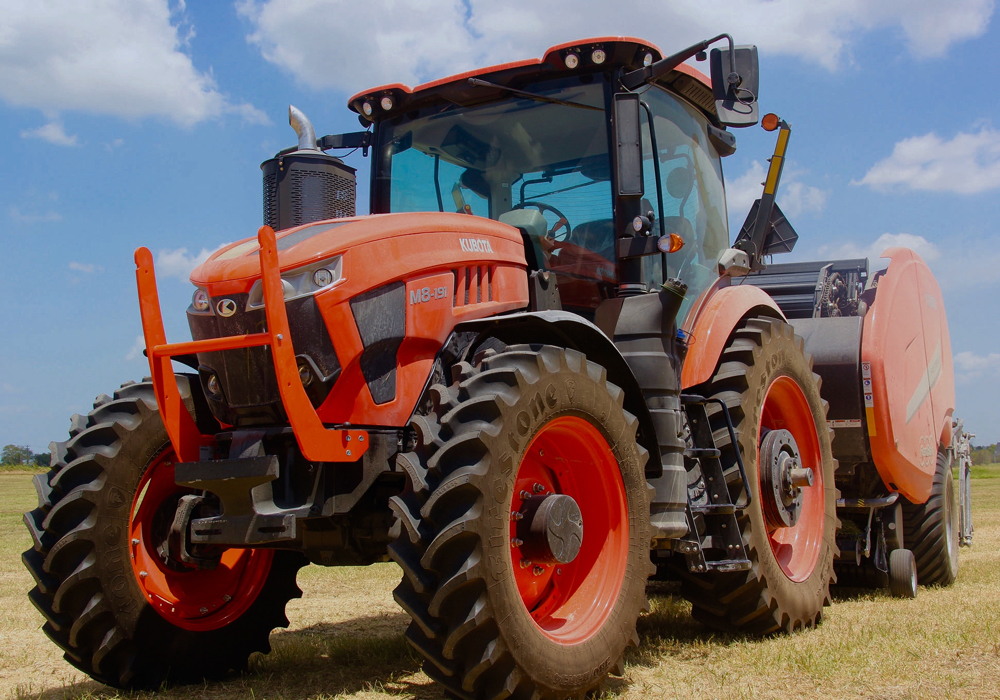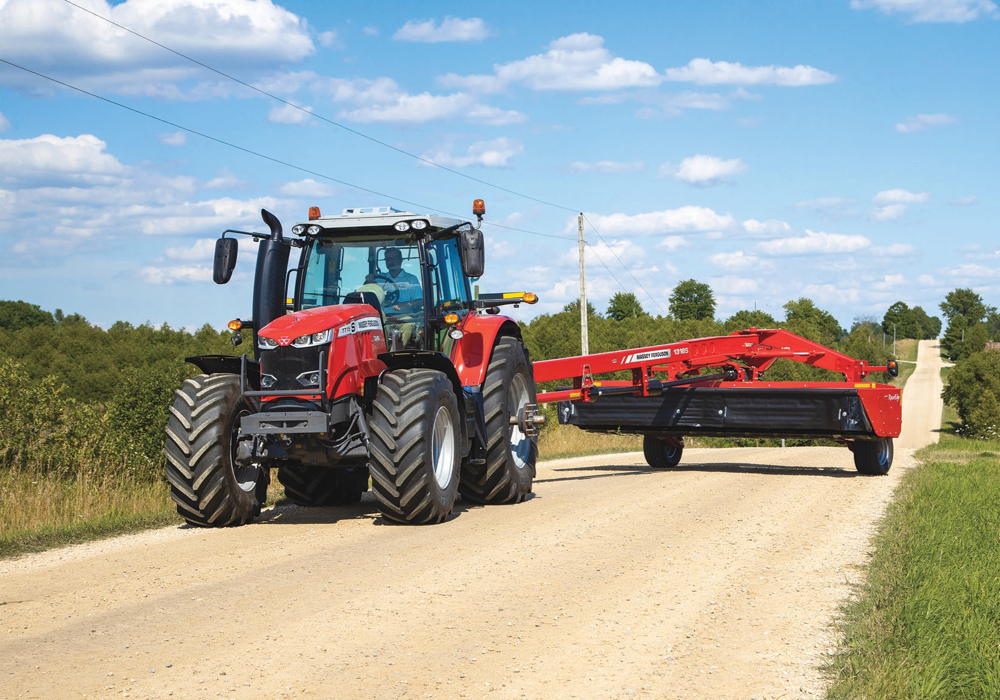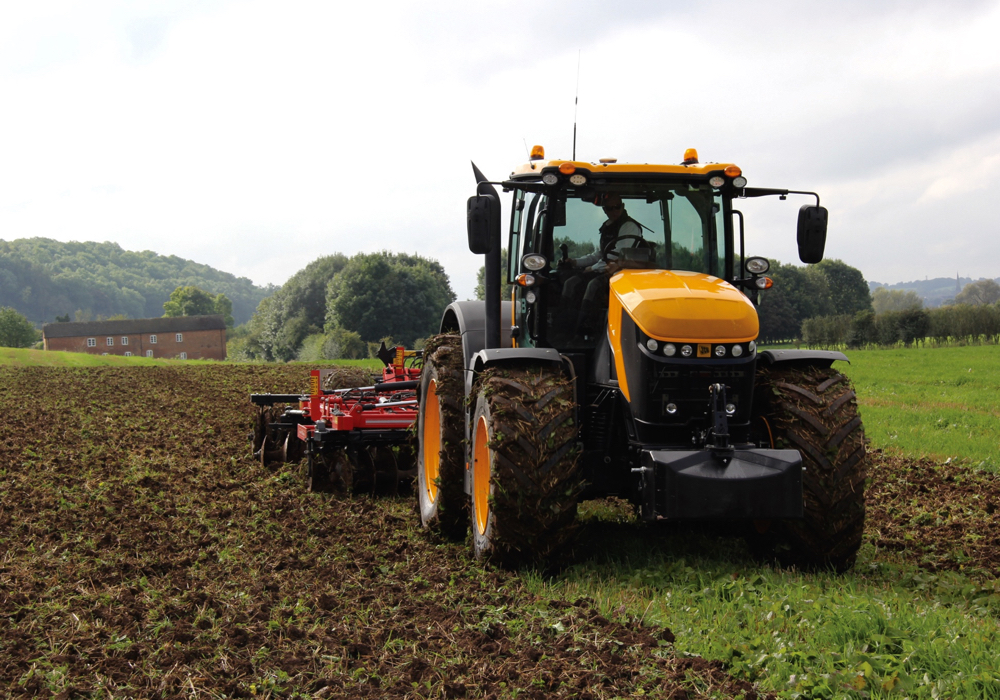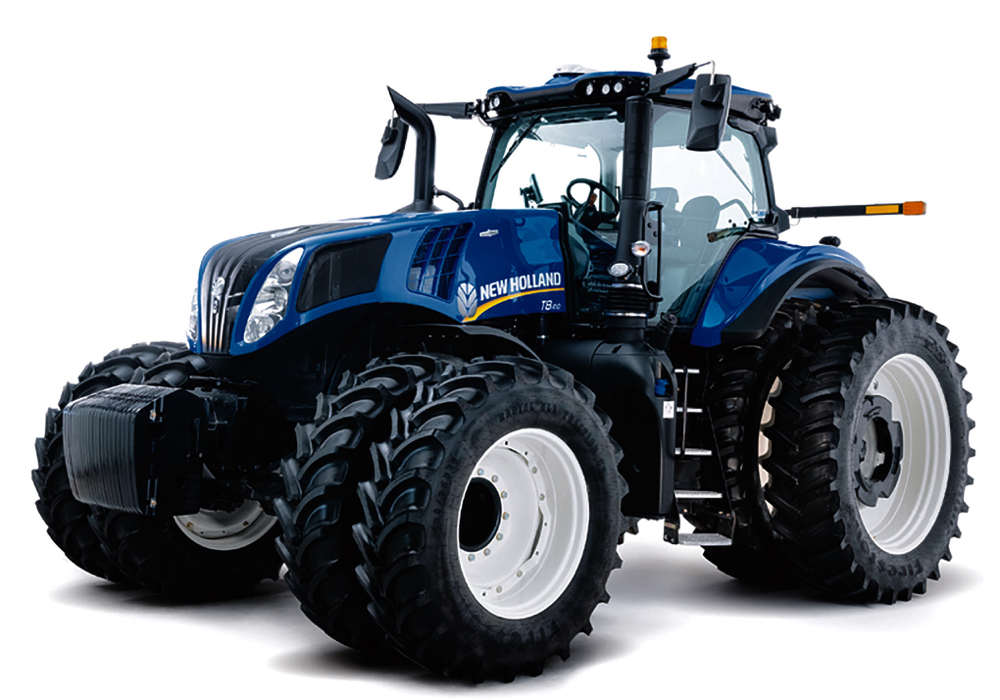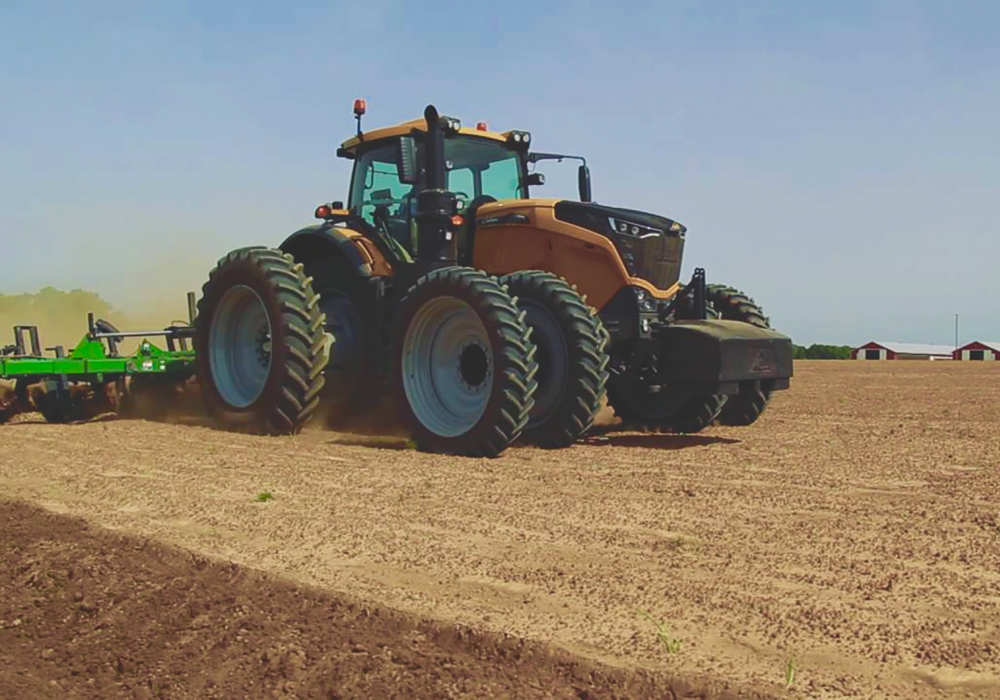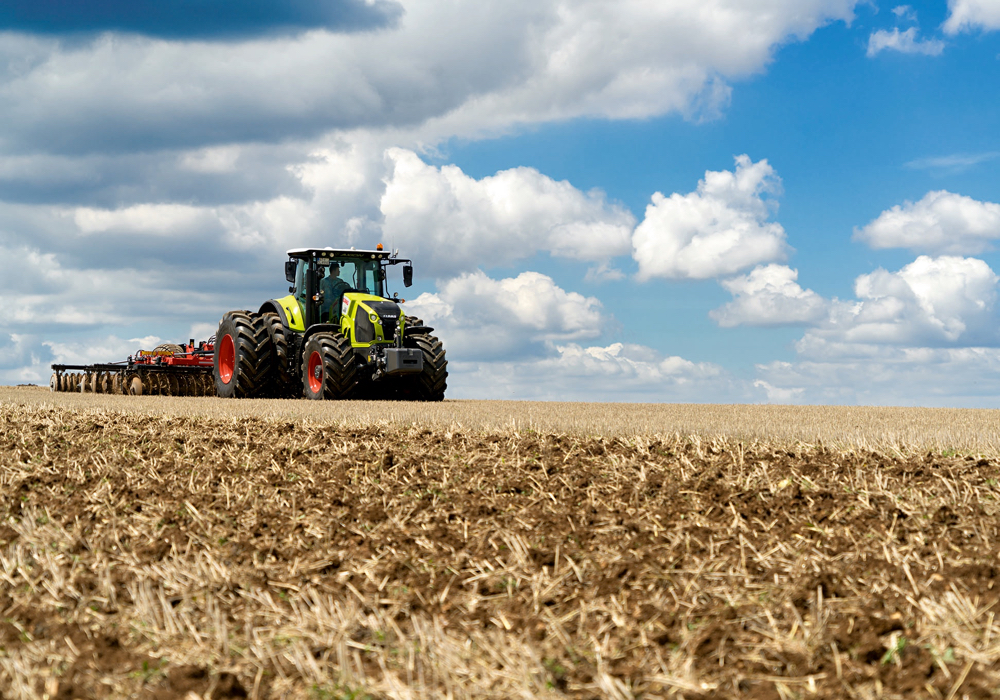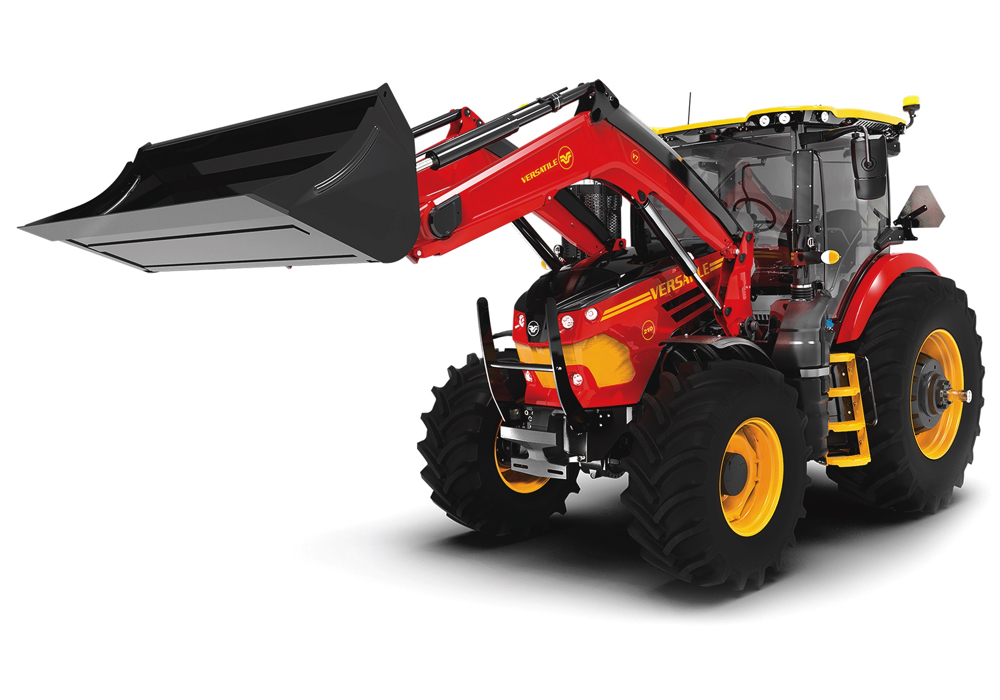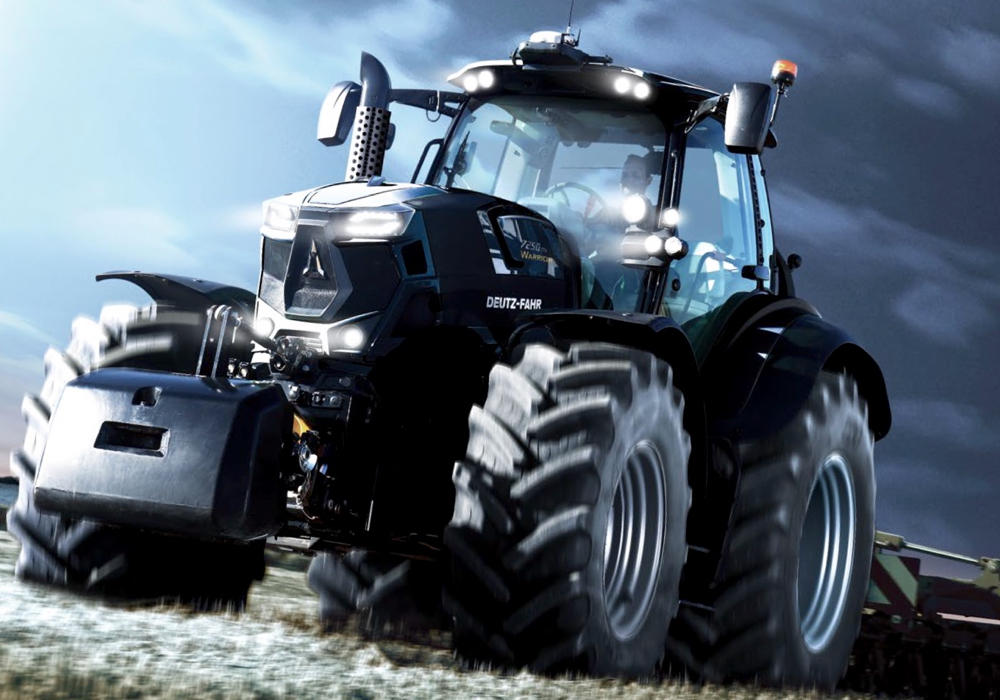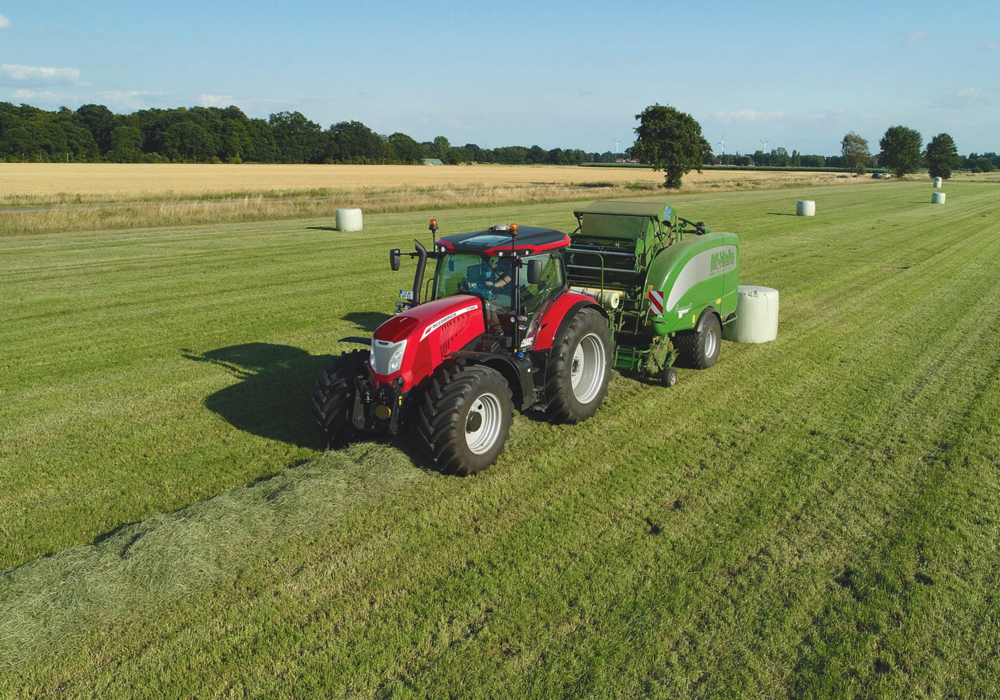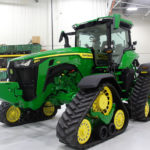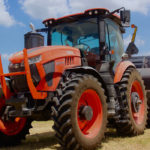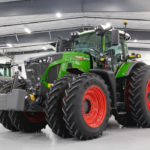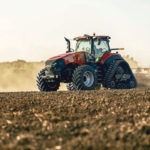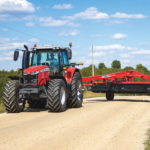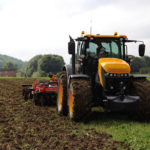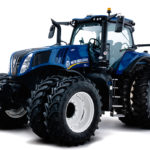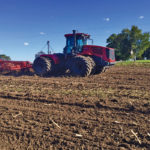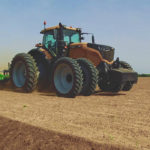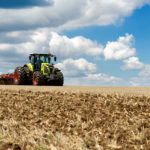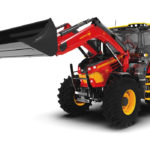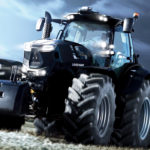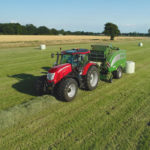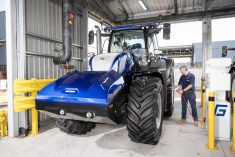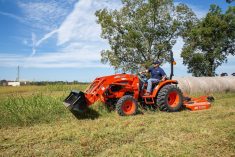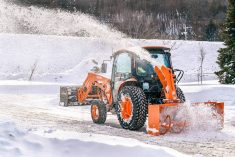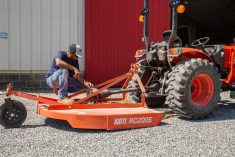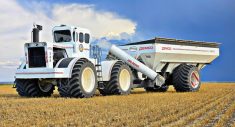
John Deere
John Deere’s 9R family of tractors continues to offer articulated wheeled, two- and four-tracked models from 370 to 620 engine horsepower. But in 2019 there was big news from the green brand about other model ranges it offers in the high horsepower segment. The company unveiled the results of a major revamp to its 7R and 8R tractor families that includes new styling, rejigged engineering and, most notably, an industry first with the new 8RX line. The 8RX models are the first rigid-frame tractors to roll out of a factory riding on four rubber track modules. Four models make up the 8RX Series, which span the 310 to 410 horsepower range. (In fact all models in the 8R line will get a boost up to 410 horsepower.) And these aren’t just regular 8R models with bolt-on track systems. The drivelines in these tractors have been engineered specifically for tracks. That includes completely new axles that can handle the added torque. Those axles make the 8RX tractors stand a couple of inches taller than their other brothers in the 8 Series. And at the top of that higher cab roof is a built-in GPS receiver, a feature that will appear on all 7R and 8R tractors for the 2020 model year. Riding on four tracks means wheel slip will be very low, because of the extra traction those rubber belts create. So there isn’t a need for a lot of ballasting. The tractors weigh in at around 41,000 pounds on up to about 44,500. And there won’t be much of a range to increase it. There will be a choice of axle spacing up to 120-inches, so it will accommodate any row-crop needs. The rubber belts will be offered in 18-, 24- and 30-inch widths. But the 30-inch tracks are only available on the back of the machine. While Deere engineers confirm the company has used a variety of components from its 9RX driveline systems, it isn’t just a blend of off-the-shelf components, the drivelines were tailored specifically for the 8RX. Deere has given the four-track 8RX tractor line new styling as well as new engineering. And the new look will transfer to all 8R and 7R models as well. Along with the new look comes new model numbering. The family designation (8) and the series (RX) will now appear near the front of the hood. The engine horsepower rating stands alone a little farther back along the side. Overall, the 8R line now has seven models available from 230 to 410 engine horsepower, while the 7Rs will now be available in seven models from 210 to 330. So in that overlap area there are several models in both ranges to choose from. Finally, Deere has made it easier for owners to do their own diagnostic work on these tractors, which is a result of criticisms levelled at all brands in the right-to-repair debate that has raged mostly in the U.S.
Photo: Scott Garvey
Kubota
“We’re not here as a flavour of the month,” Bob Hickey, president of Kubota Canada told the brand’s dealers at the introduction of the new M8 tractor line in Texas in July, 2019. And all the messages telegraphed by management at that event clearly indicate Kubota intends to keep driving toward a fuller market share in the ag equipment sector. The M8 tractor line is a key step in that direction. The two new tractors that make up the M8 Series take up where the M7s leave off. (The M7s top out at 168 engine horsepower.) There are two models: the 190 engine horsepower M8-191 and 210 horsepower M8-211. These tractors will, as expected, share a base platform with Versatile’s Nemesis line and will be built for Kubota in Winnipeg at Versatile’s assembly plant. A 6.7-litre Cummins will supply the muscle that can be routed through a fully electronic 30x15 power shift transmission, which includes a shuttle shift with either a 40 or 50 km/h. top speed. Or the tractors can be equipped with an optional 50 km/h.-capable CVT. The powershifts offer six on-the-go gear changes in each range. And the transmission will auto shift up to a pre-set speed as well as downshift when the engine lugs down to a pre-set limit, making this a simple tractor to operate. These MFWD tractors can be equipped with a rigid or suspended front axle. The suspended-axle versions also get cab suspension to significantly soften the ride for an operator. At the rear, a 540 or 1,000 r.p.m. PTO can be operated in both standard and eco modes. A 1¾-inch, 20-spline shaft is also available as an option. Three-point hitch lift capacity is 5,660 kilograms, but that can be raised to 7,050 as an optional feature. A hydraulic flow rate of 120 l/min. is standard, but that can be boosted up to an optional 160. Three rear remotes are standard, with five as an option there. With 148 cubic feet of interior space, the cab is larger than the M7’s, but the control armrest is identical. Inside the cab, a seven- or 12-inch LCD touch screen monitor is fully ISOBUS compatible, allowing the tractor to maximize communication with any compatible implement from any brand. Built into the tractor’s brain is a customizable headland control feature to automate turns in the field. And Kubota has decided to use an open architecture system to make the tractor compatible with any GPS auto-steer system currently on the market. Kubota will also allow buyers to pair an M8 with the new self-levelling M77 front-end loader, which includes shock-absorbing hydraulic accumulators that cushion the tractor and loader arms from hard shocks when going over rough terrain. The joystick that controls the loader has a third-function feature that allows for grapple control. And there is even a fourth function available as an upgrade. The M77 loader has a 2,360-kilogram load rating at maximum lift height and a breakout force rating of 4,600 kilograms. So these tractors offer capacities well beyond what most utility category tractors can offer.
Photo: Scott Garvey
Fendt
AGCO’s Fendt brand has been offering the 700, 800 and 1000 Series tractors in North America for a while now. Those lines span the 145 to 517 engine horsepower range. But making the jump from the 800 to 1000 Series left a gap in its high-horsepower rigid frame offerings. In late June the brand plugged that hole when it debuted the 900 Series Gen 6, which offers five models between 296 and 415 engine horsepower. They are essentially smaller versions of the unique 1000 Series tractors introduced a couple of years ago. And they use the same VarioDrive system that was introduced on that line. That system is similar to the all-wheel drive concept used on sports cars. Power goes through the single-range CVT transmission then toque gets directed to the axle that needs it most. So there is no need for the standard wheel brake pedals in the cab, because the torque distribution delivered by the VarioDrive system makes them unnecessary. This system is similar to the technology commonly found in high-performance luxury vehicles. AGCO has incorporated into it a high-horsepower tractor. Like the 1000 Series, the 900s get an MAN diesel under the hood, but this time it’s 9-litre version. It operates at a leisurely idle speed of 650 r.p.m. and a maximum of 1,700. Behind it, of course, is Fendt’s CVT transmission. The base hydraulic system is a 58 GPM single pump. An additional 43 GPM pump can be added to provide a dual circuit. The optional dual pump configuration is able to provide up to 100 GPM, at 1,100 to 1,400 engine r.p.m. It can hit a maximum flow of 113 GPM at full throttle The company claims this tractor series has been specifically designed for farmers here in the North American market. It gets new track width options, so it can fit right into typical North American row-crop fields, something other Fendt models couldn’t do and held back demand for the brand’s other mid-horsepower offerings. AGCO is positioning Fendt as a high-quality, premium product and packing a host of options into the green machines, something it claims will help make it them the most efficient on the market, like the camera integrated into the front hood, which displays on the 10.4 inch Vario Terminal. The brand is also offering its Gold Star customer care program for the 900s, which provides a three-year, 3,000 hour warranty and service package four our tractors. Fendt’s marking reps say Gold Care will keep customers running in the field longer and provide a lower total cost of ownership for the customer. It also includes full maintenance, including oils, filters, belts and other items in the general maintenance plan.
Photo: Scott Garvey
Case IH
At the top end of Case IH’s tractor family is the articulated line of Steigers. Wheeled versions span the 370 to 620 engine horsepower range. The five Quadtrac models start at 470 horsepower and the three Rowtrac models go from 420 to 500 horsepower. The Steigers offer both powershift and the brand’s CVXDrive CVT transmissions. The high-horsepower, MFWD Magnums, though, were where the brand had news to reveal this year. They were given a new look along with a host of digital features and named the AFS Connect Magnums, referencing the brand’s existing telematics products. The new body styling looks similar to the autonomous tractor Case IH revealed back in 2016. The reason for that, claims the brand, is because these models represent the next generation of technology packed into a tractor as the industry gradually moves toward full autonomy. It pulls together a lot of new systems to allow the Magnums to communicate and stay connected in the field. The new Pro 1200 monitor in the cab expands on the functions of the previous Pro 700. In fact, most of the tractor systems can be controlled through it, and it makes guidance inputs much simpler. The software that runs the Pro 1200 is based on the same Android technology most people are familiar with in their mobile devices. Inside the cab is a new control layout, but the new AFS Connect Magnum versions will have two or three ways to activate tractor systems. Those who are familiar with manual controls on the armrest will still find them there, although some will be in different locations. Virtually everything can be controlled through the Pro 1200 monitor. Guidance is run through a new receiver that incorporates all the necessary guidance correction hardware into it, eliminating the need for a second computer inside the cab to facilitate corrections. The new technology allows for improved mechanical diagnostics and wireless transfer of data, including GPS guidance lines. The digital features built into the AFS Connect Magnums won’t remain unique to model year 2020 tractors; the technology is partly backwards compatible. So it can be retrofitted onto existing late model Magnums as well. It’s compatible with everything back to the Tier 3 time period. When it comes to the tractor itself, the new hood and cab styling are designed to make operation easier and the operator more comfortable. Slimmer cab pillars and a new, brighter interior colour along with more creature comforts give the new cab an updated feel. There is better storage and more visibility out of it, as well as a larger door that opens up the fill width of the cab, eliminating the B pillar and making entry easier. To smooth out the ride there is a new adjustable front axle suspension, which is controlled through the monitor. Paired with it is a semi-active cab suspension. In August the brand bumped up the maximum horsepower rating for the line, adding a 400 horsepower version of the AFS Connect Magnum.
Photo: Case IH
Massey Ferguson
AGCO’s Massey Ferguson brand has pushed at the upper end of its horsepower ratings, too. The 8740S becomes the flagship model of the updated six-model 8700S Series tractor line, and it rates 400 engine horsepower, making it the most powerful tractor to ever wear the Massey name. The big Masseys rely on an 8.4-litre AGCOPower diesel and route drive through the brand’s 50 km/h-capable Dyna-VT CVT transmission, which uses AGCO’s Dynamic Tractor Management system. It can maintain a pre-set ground speed by adjusting engine power to accommodate changing loads. It also allows on-the-go changes between two cruise speeds. The Dyna-VT has two speed ranges that allows for maximum torque in field operations. Like a lot of transmissions hitting the market now, the Dyna-VT includes a “brake to neutral” feature, allowing the operator to stop the tractor by simply pressing the brake pedal. Release it and the tractor starts off again. To ensure the transmission isn’t contaminated by trans-hydraulic fluid from an implement, the Dyna-VT uses its own dedicated oil reservoir. A front three-point hitch and PTO are available as an option. The six 8700S tractors begin at the 270 horsepower mark and increase from there. Below them is the 7700S Series, which offers seven models and two chassis sizes. The large-frame models use either a 6.6- or 7.4-litre diesel mated with the dual-clutch Dyna-6 powershift transmission. The smaller models use the 6.6 mated to either a Dyna-6 or Dyna-4 A couple of years ago, Massey began introducing its “S” Effect models. The existing 7700 and 8700 lines have now been given the same S Effect treatment, hence the S added to the model numbers. S models get updated styling and a range of new options. As part of that an available new LED light package improves night vision. The new styling includes some changes inside the cab as well, which includes updated control layouts.
Photo: AGCO
JCB
The current 8000 Series Fastrac tractors from JCB began full production in 2017. These models have seen only minor updates for 2020 and specifications for the newest model year remain essentially the same as last year. The two newest 8000 Series models pushed the Fastrac line’s top engine horsepower ratings to 280 in the 8290 and 335 in the 8330, with peak horsepower numbers hitting 306 and 348 respectively. The equal-wheeled machines with the same mid-mounted cab and rear deck design used on the smaller 4000 Series have been signature features that defined the basic Fastrac design since its introduction in 1991, although the current 8000 Series uses slightly smaller front wheels. The engine and transmissions under the 8000 Series hoods are from AGCO, so some parts availability stretches well beyond dedicated JCB dealers. An 8.4 litre SISU (AGCOPower) diesel mates to a programmable Fendt CVT transmission. That allows the engine management system to run the tractor at the lowest possible r.p.m. during field operations (or it can be set for other priorities like field speed) and keep torque where it needs to be while minimizing fuel consumption, even in changing field conditions. The ActivTraction feature monitors wheel slip and throttles down the engine until traction returns, and then the tractor picks up ground speed again. The 8000 Series tractors abandoned the earlier mechanical steering linkage design for a hydrostatic dual-steer system. Two independent fluid circuits provide a fail safe system in the event of a failure in one or the other, and optional Rapid Steer changes the affect of steering wheel input based on ground speed, heightening sensitivity for low field speeds and reducing it for high road speeds.
Photo: Scott Garvey
New Holland
The new Genesis T8 with PLM Intelligence was introduced this year, which mirrors its cousin the Case IH AFS Connect Magnum. It offers features such as advanced connectivity between operators, vehicles, advisors and dealers, which are intended to improve productivity and reduce downtime. There are also customizable controls, improved visibility and enhanced comfort. The updated cab design offers a more comfortable and convenient driver experience. “Next-generation” controls can be easily customized, allowing every operator to set them up based on their unique preferences and requirements. The new cab features more accessible storage, increased number of power ports and vents, egress lights, and an ergonomic seat for optimal comfort. Designers have removed obstructions to ensure operators have maximum visibility from the seat. The new InfoView monitor is positioned in direct line-of-sight on the dash, so operators can keep their eyes on the horizon ahead and still see vital readout information. Built-in cameras make it easier to keep an eye on in-field work and other tasks, with one camera in the grille another at the rear cab roof, both with 180-degree vision. Another pair of implement cameras can be mounted lower down on the rear of the cab. New 360-degree LED work lights deliver up to 25 per cent more light to make it easier to see implements when working at night. Inside the cab, the brand has a new more ergonomic SideWinder Ultra armrest that includes the IntelliView 12-inch monitor, which can handle up to four video inputs. But the brand claims the most innovative features extend far beyond the cab with complete integration of New Holland’s PLM platform, using ISOBUS CLASS III technology. NH offers the digital MyPLMConnect Internet connection, which allows for data sharing and can include enhanced support functionality through a local New Holland Dealer. This is all done through a simple tablet-based user interface. The T8 with PLM Intelligence line includes five models from 320 to 435 engine horsepower, plus three more in the SmartTrax configuration.
Photo: New Holland
MTZ
MTZ Equipment continues to offer the 435 horsepower Russian-built Kirovets K744 to the big-tractor market in Canada, and with a base price of $289,000 (as of 2019), their market advantage still comes down to basic horsepower at a lower cost. Although the current machines don’t offer sophisticated, high-end electronics, they do have more than a few modern features to offer. Powering the K744 is a Tier 4-compliant turbocharged Mercedes Benz diesel. Behind the German engine is a 16-speed partial powershift allowing four on-the-go gear changes within each of four forward ranges. Moving the hydraulic pump from under the cab and changing control mechanisms a couple of years ago has also allowed for a much quieter cab. And air ride cab suspension has been made standard. The drawbar tongue load rating is 11,000 pounds up from the previous 4,000 on earlier versions. Tire size availability ranges up to 710/70R38s. Wide Mitas 1050 tires are also an option. Bolt-on track modules with 30- or 36-inch rubber belts are available as well. No internal driveline changes are necessary to handle tracks. The brand claims the components in the system are overbuilt for durability and can easily handle both tires and tracks. The tractor rides on a suspended front axle and has a 74 GPM (280 l/min.) hydraulic flow rate. It comes equipped with a category III and IV three-point rear hitch, which has a lift capacity of 9,000 kilograms. K744s use a dedicated pump for power steering and the transmission demands. So the full 74 GPM flow is available for implements. There are five hydraulic outlets (one of them is connected to the three-point hitch). Each one can deliver up to 37 GPM (140 l/min.) per outlet.
Photo: MTZ
Challenger
Challenger 1000 Series models are the same basic tractor as those wearing AGCO’s Fendt brand badges. The same tractors get treated to green or yellow paint depending on which dealership they are delivered to. The 1000 Series offer really big horsepower in a rigid-frame MFWD configuration. Four models offer 396 to 517 engine horsepower (380 to 453 at the PTO). A low-rev. 12.4 litre MAN diesel provides the power in the series and the unique AccuDrive powertrain that routes drive to the axle where it’s needed most. The two-tracked MT700s come in three models, which run from 380 to 431 horsepower, sport styling that matches the look of the 1000 Series tractors. Underneath their skin, the two-track machines were given so many engineering changes that AGCO called them the “next generation” MT700 Series when they last saw an update. Built on the AccuEngineering Platform and including the MobilTrac system (track suspension), the MT700s rely on 9.8 Litre AGCO Power diesel engines. Just like the 1000 Series engines, the 9.3 litre diesels offer high torque at low revs, which helps reduce fuel consumption because the engine runs at a relatively low r.p.m. Behind the engine, the AccuDrive powertrain uses a CVT. The brand claims these systems all work together to make the tractors much more efficient at turning engine torque into useable traction. MaxxRide three stage suspension system includes oscillating mid-rollers, a redesigned hard bar suspension and lastly a cab suspension. Those features also improve handling on roads at higher speeds. A 10.4-inch touch screen relays information to the operator. The monitors are ISOBUS 11783-compatible, and they can display real-time camera images and handle wireless data transfer tasks.
Photo: AGCO
Claas
In 2018 Claas introduced its 210 to 290 horsepower Axion 800 Series tractors to Canada. As the brand continues to grow the number of all-Class full-line dealers in North America, it now has even more to offer farmers with the introduction of the Axion 900 Series MFWD tractors. That pushes the brand’s MFWD horsepower range up to 445. Power for the 900 Series comes from an 8.7 litre FPT (Fiat Powertrain) diesel — the same engine builder supplying Case IH and New Holland equipment — mated to a CVT transmission capable of creeping forward at just 2.7 feet per minute. At the top end the tractors will move down the road at 31 m.p.h. with the engine revving at only 1,750 r.p.m. The engine can run for up to 600 hours between service intervals. When it comes to hydraulics, the tractors will pump 58 GPM through a standard four SCVs. But that number can be boosted to 6 SCVs. Both front and rear three-point hitches and PTOs are also an option. Underneath, the 900s are available with the HD PROACTIV suspended front axle that comes equipped with brakes for better control during road transport. A four-point cab adjustable cab suspension is standard equipment to make the ride even smoother, along with an optional heated leather operator’s seat. A cooler inside the cab keeps drinks and food cold through the day. Mounted to the armrest is the brand’s CEBIS information screen. A telematics package comes standard to help manage machinery functions, which allows for remote diagnostics by a dealer. Also an optional LED package improves vision at night Aside from the 800 and 900 Series Axion lines, Claas continues to offer its unique Xerion rigid-frame four-wheel drives as well. Available in three models with 435 to 530 horsepower, the Xerions get their power from a 10.6 or 12.8 litre Mercedes Benz diesel engine. That power is routed through a CVT transmission.
Photo: Claas
Versatile
The “heritage” look brought to Versatile brand tractors and sprayers in 2017 continues through to 2020. But some new tractors have been added to the line to wear that livery, particularly the Nemesis line. They’re an addition to the brand’s other five-model MFWD line that offers 2715 to 365 engine horsepower and began production in late 2019. Three Nemesis tractors offer 175 to 210 horsepower, adding to the lower end of Versatile’s previous MFWD horsepower offerings. 6.7 litre Cummins engines will power all three Nemesis models, and that power gets routed through a 49 km/h. 30 X 15 powershift transmission. And an optional version capable of 50 km/h. is available. Nemesis tractors can be ordered with either standard or suspended front axles offering a 55-degree turning angle. A closed-centre hydraulic pump capable of 31 GPM (120 l/min.) comes standard. But buyers can opt for 42 GPM (160 l/min.) upgrade instead. Three SCVs are standard with the lower flow pump. But that can be bumped up to five with the high-flow option. The brand’s articulated line of four-wheel drive models will continue to top out at 610 horsepower in both wheeled and Delta Track versions. New engine management software and redesigned planetary gear was introduced for 2019 in all the large-frame tractors, resulting in a boost in torque to the drive wheels. That jump, 15 per cent in the Delta Track and seven per cent in the wheeled models, put extra muscle in front of the drawbar by ensuring more of the power from the Cummins engines reaches the ground.
Photo: Versatile
Deutz Fahr
Occupying the flagship spot in Deutz Fahr’s North American line is the 9340 TTV Warrior tractor with 316 horsepower under the hood. The “Warrior” model, which is also available as a 7250 TTV, is the brand’s premium, “limited edition” tractor. The maximum power rating on the 9340 offers another 20 horsepower, bringing the tractor up to 336 horsepower when needed. The 7250 is rated at 230, but jumps to 246 with its maximum horsepower rating. The Warriors mate their Deutz-Fahr-built diesel engines — a 6.1 litre in the 7250 and a 7.8 litre version in the 9340 — to the brand’s TTV continuously variable transmissions, which offer both “Auto” and “Manual” driving functions. The TTV can creep the tractors along as slow as 0.2 km/h. or move them down the road at up to 60 km/h. at reduced engine RPMs. The Warriors can be made to stand out from their brothers in the Deutz-Fahr tractor lines with a unique black paint scheme, or they can also be ordered in standard Deutz-Fahr green. At e rear the 9340 has a three-point hitch lift capacity of 12,000 kilogram and an optional hydraulic output hits 210 l/min. 160l/min. is standard. The 7250 gets a rear lift rating of 10,000 kilograms and a hydraulic pump that can push out 120 l/min. That can jump up to 160 as an option. Both models use a load-sensing pump. Like the other tractors, inside the cab Warriors use the brand’s 12-inch iMonitor 2.0 to handle tractor data and precision farming functions. The iMonitor is capable of handling ISOBUS-compatible implement functions. It can also handle input from up to two remote cameras. The 9 Series TTV Agrotron line includes three models that offer 277 to 316 horsepower with 40, 50 and 60 km/h. transmission options. In the 7 Series, there are two standard models, the 7230 and 7250 that offer engine horsepower ratings of 214 and 230. Deutz-Fahr offers tractors equipped with adaptive front suspension that includes front dry-disc brakes on tractors. A booster system allows for maximum brake pressure with only light pedal application.
Photo: Deutz Fahr
McCormick
McCormick’s largest tractor range remains the X8 Series, with three models offering 264 to 310 engine horsepower. Below them is the four-model line of X7 tractors that span the 165 to 225 horsepower range. In 2017 Argo, the Italian parent company behind the McCormick brand, added new models to the X7 Series, and for 2020 it again turned its focus to that tractor line. At Agritechnica, the world’s premiere machinery show in Germany, McCormick showed its latest innovations to that line. Most notably, it debuted the X7.624 model that pushed the maximum engine horsepower rating for the line to 240. The brand’s 6.7-litre “Beta Power” diesel will deliver that muscle, and the engineering behind it was given an upgrade to meet Europe’s Stage V emissions compliance requirements. To get there, 6.7 Beta Power breathes out through an SCR system combined with a DOC (Diesel Oxidation Catalyst). But the engine also gets more than just clean breath, an engine braking system has been added to make it a handier tractor for transport jobs like pulling a grain cart. Engine cooling has been improved with the addition of pull-away coolers and radiator. Service intervals have been increased with improved filtration to minimize operating costs. That power plant will get mated to the brand’s VT-Drive CVT transmission, which is built by the German component manufacturer ZF. Four operating ranges allow the tractor to creep along at 0.04 km/h. or hustle down the road at up to 50 km/h. Independent front axle suspension allows for improved traction and a smoother ride. The brand’s DSM (Data Screen Management) system has been reconfigured and is fully ISOBUS compatible. Up to five programmable functions for job tasks can be stored and used in field operations. While the tractor has just debuted in Europe, the brand hasn’t yet said when it will be available here in Canada.
Photo: McCormick
It’s been suggested by industry insiders that 2019 could be called the year of the tractor, because there were so many new introductions of them. That means even more choices for producers looking to re-power their farm fleet.
Kubota, which has been gradually working its way into the mainstream agriculture sector with a steady stream of new product introductions through the last several years, can now be officially considered a serious player in the mid-horsepower tractor segment. The introduction of its M8 Series now brings the orange brand’s available tractor horsepower above the 200 mark.
Read Also

Claas brings 1000 Series SP forage harvesters to Canada
In mid-August, Claas unveiled its new line of Jaguar forage harvesters at an event in Visalia, California, deep in the heart of that state’s dairy region.
John Deere broke out of the conventional tractor moulds with its introduction of the 8RX four-track, rigid-frame models, which means it now offers three different versions of the 8R design. And it updated the design and engineering in all 8R models as well as the 7R Series
Winnipeg-based Versatile added the Nemesis line of MFWD tractors to the lower end of its horsepower range.
And at Agritechnica, the world’s largest most prestigious farm machinery show, brands, including John Deere, gave attendees a look at some autonomous and technologically advanced tractors that may soon be available on the market. All of that means its been another exciting year for those following trends in the farm machinery sector.


